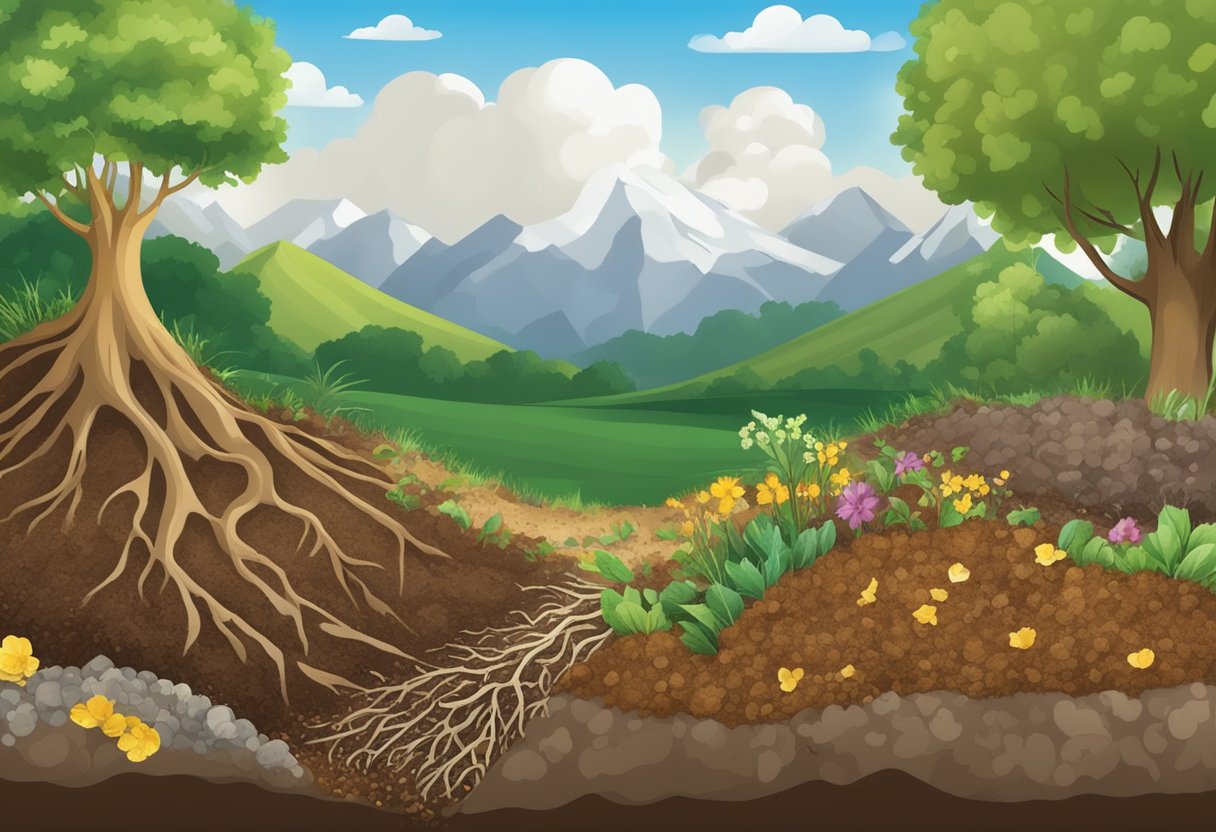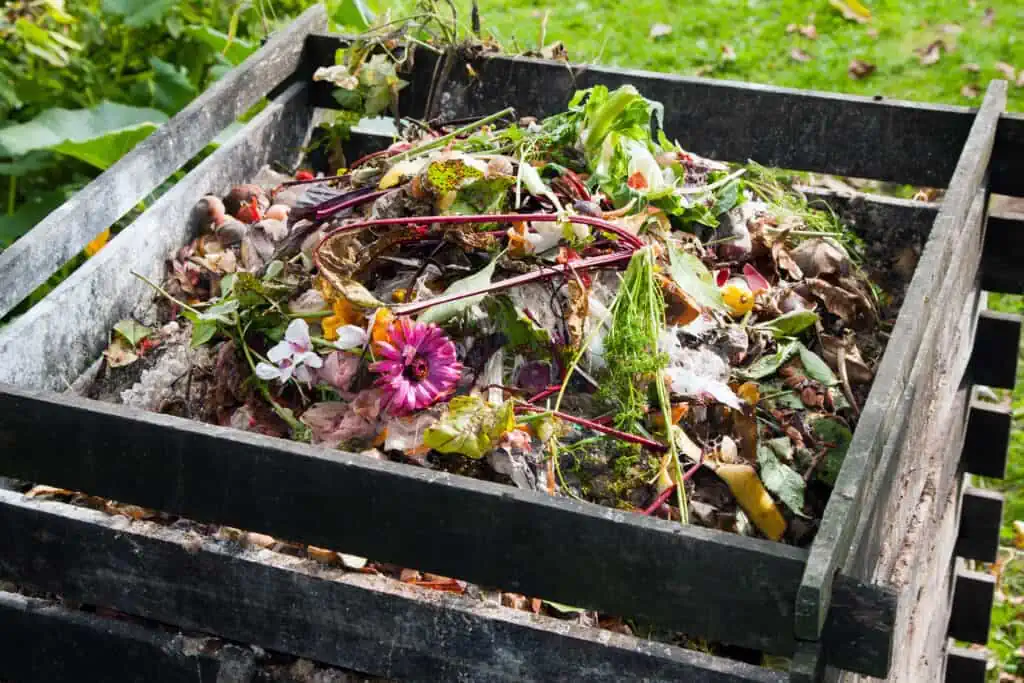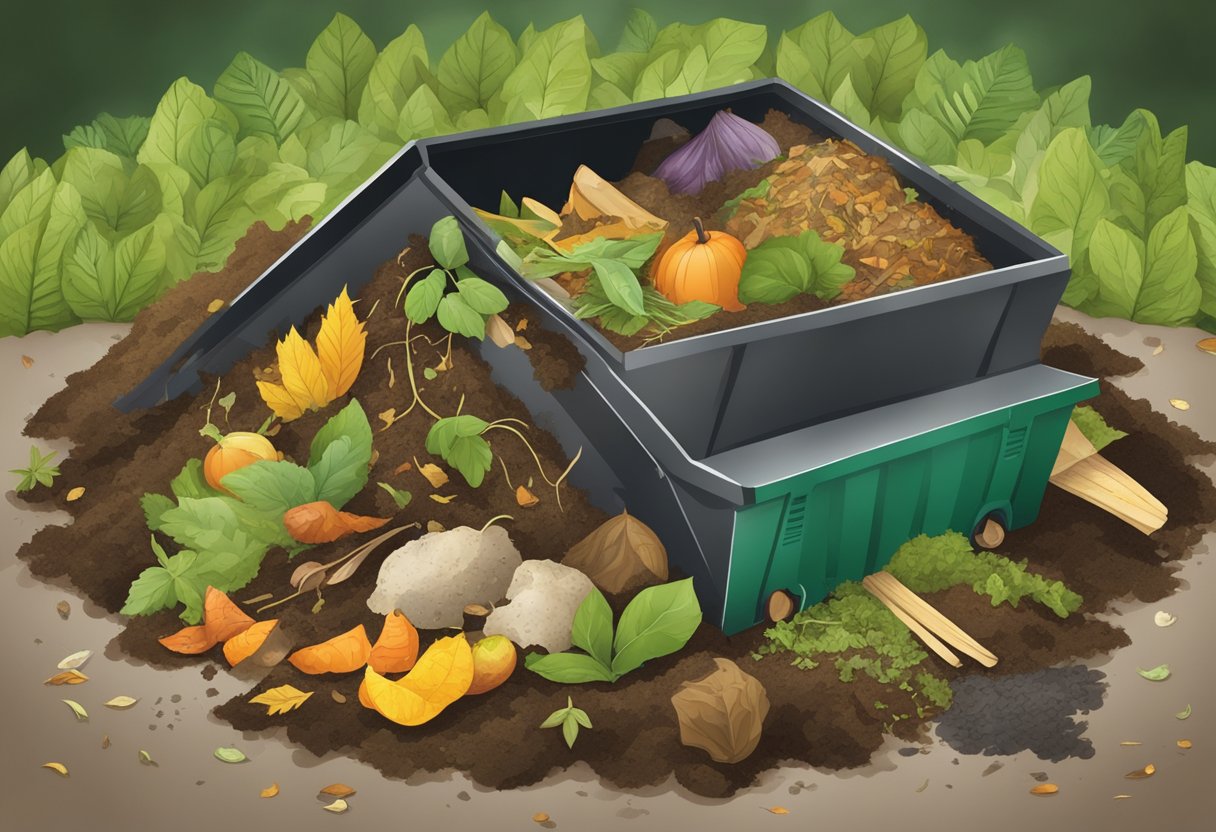As an Amazon Associate I earn from qualifying purchases.
At A Glance
Compost is the nutrient-rich, soil-like material produced from the controlled decomposition of organic matter. Through the composting process, microorganisms, insects, and earthworms break down materials such as food scraps, yard waste, and other organic debris into a humus-like material. Compost is valued for its ability to improve soil structure, provide a variety of essential nutrients for plants, and help retain soil moisture.
Compost is a term that is often heard in the gardening and farming community. It is a mixture of organic materials that are used to enrich soil and provide nutrients to plants. Composting is the process of breaking down these materials into a nutrient-rich soil amendment.

There are many different materials that can be used to make compost, including food waste, yard trimmings, and manure. The process of composting involves microorganisms such as bacteria, fungi, and nematodes breaking down these materials into a crumbly mass of rotted organic matter. Composting is a controlled, aerobic process that reduces methane emissions and provides beneficial microbes for crops.
Overall, composting is an environmentally friendly way to dispose of organic waste while also improving soil fertility. It is a simple and effective way to create a nutrient-rich soil amendment that can be used to grow healthy plants. Whether you are a seasoned gardener or just starting out, composting is a valuable tool that can help you achieve your gardening goals.
Understanding Compost

Definition of Compost
Compost is a nutrient-rich soil amendment that is produced through the controlled aerobic, biological decomposition of biodegradable materials. The process of composting involves the breakdown of organic matter into a stable and mature product that can be used to enrich soil and support plant growth. The end product of composting is a dark, crumbly material that has a pleasant earthy smell.
Compost Composition
The composition of compost is critical to its effectiveness as a soil amendment. Compost should be made up of a balanced mix of “green” and “brown” organic materials. “Green” organic materials, such as grass clippings, food scraps, and manure, are high in nitrogen and provide the energy source for the microorganisms that break down the organic matter. “Brown” organic materials, such as dried leaves, wood chips, and straw, are high in carbon and provide the structural component necessary for good compost.
Composting also requires the proper amount of moisture and oxygen. The ideal moisture content for compost is between 40% and 60%, and the compost pile should be turned regularly to ensure that oxygen is available to the microorganisms that are breaking down the organic matter.
Compost and Soil
Compost is an excellent soil amendment that can improve soil structure, increase water-holding capacity, and provide essential nutrients to plants. When added to soil, compost can help to increase microbial activity, which is critical for healthy plant growth. Compost can also help to reduce erosion and runoff, which can improve water quality in nearby streams and rivers.
In conclusion, compost is a valuable resource that can help to improve soil health, support plant growth, and protect the environment. By understanding the definition of compost, the composition of compost, and the benefits of compost for soil, gardeners can harness the power of composting to create healthy, productive gardens.
Composting Process
Composting is the process of breaking down organic matter into a nutrient-rich soil amendment. This process involves the controlled decomposition of biodegradable materials, such as food scraps, yard waste, and manure. The decomposition process is facilitated by microorganisms, such as bacteria, fungi, and other decomposers.
Decomposition Process
The decomposition process is a complex series of biochemical reactions that break down organic matter into simpler compounds. During this process, microorganisms consume the organic matter and convert it into carbon dioxide, water, and other byproducts. The decomposition process requires a proper balance of “green” organic materials and “brown” organic materials. “Green” organic material includes grass clippings, food scraps, and manure, which contain large amounts of nitrogen. “Brown” organic material includes leaves, straw, and wood chips, which contain large amounts of carbon.
Aeration and Moisture
Aeration and moisture are critical factors in the composting process. Microorganisms require oxygen to carry out the decomposition process. Without adequate oxygen, the decomposition process will slow down or stop altogether. Moisture is also important, as it helps to keep the compost pile from drying out. A compost pile that is too dry will not decompose properly. Conversely, a compost pile that is too wet will become anaerobic, which can lead to unpleasant odors and slow down the decomposition process.
Temperature Management
Temperature management is another critical factor in the composting process. The decomposition process generates heat, which can raise the temperature of the compost pile. The ideal temperature range for composting is between 120 and 160 degrees Fahrenheit. Temperatures above 160 degrees Fahrenheit can kill off beneficial microorganisms, while temperatures below 120 degrees Fahrenheit can slow down the decomposition process. To maintain the ideal temperature range, it is important to turn the compost pile regularly and monitor the temperature with a compost thermometer.
In summary, composting is a natural and beneficial process that involves the controlled decomposition of organic matter. The decomposition process is facilitated by microorganisms, which require a proper balance of “green” and “brown” organic materials, adequate aeration and moisture, and proper temperature management. By following these guidelines, you can create nutrient-rich compost that can be used to improve soil health and plant growth.
Types of Composting
Composting is a natural process of breaking down organic material into a nutrient-rich soil amendment. There are several types of composting methods that can be used to create compost, each with its own advantages and disadvantages. In this section, I will discuss the most common types of composting.
Backyard Composting
Backyard composting is the most common method of composting. It involves creating a compost pile in your backyard with organic materials such as food scraps, yard waste, and leaves. Backyard composting can be done in an open pile or in a container. The open pile method is the simplest and requires minimal maintenance, while the container method is more organized and can help control pests and odors.
Vermicomposting
Vermicomposting is a type of composting that uses worms to break down organic material. It is a great option for those who live in apartments or have limited outdoor space. Vermicomposting can be done indoors and requires a worm bin, bedding material, and food scraps. The worms consume the organic material and produce a nutrient-rich compost known as worm castings.
Aerated Static Pile Composting
Aerated static pile composting is a method that involves creating a pile of organic material and then using a blower to force air through the pile. This method requires a large amount of organic material and can be used for industrial-scale composting. The pile must be turned regularly to ensure that all of the organic material is broken down evenly.
In-Vessel Composting
In-vessel composting is a method that involves placing organic material in a closed container. This method is great for those who want to compost food scraps in an urban environment. In-vessel composting can be done using a variety of containers such as drums, bins, or tumbler composters. The container is designed to allow for air flow and can be turned to ensure that the organic material is broken down evenly.
Windrow Composting
Windrow composting is a method that involves creating long piles of organic material and then turning the pile regularly to ensure that all of the organic material is broken down. This method is commonly used for commercial-scale composting and requires a large amount of organic material. The piles must be monitored regularly to ensure that the temperature and moisture levels are optimal for composting.
In summary, there are several types of composting methods that can be used to create nutrient-rich compost. Each method has its own advantages and disadvantages, and the choice of method will depend on the amount of organic material available, the space available, and the desired outcome.
Materials for Composting

Composting is the process of breaking down organic matter into nutrient-rich soil. To make compost, you need a mixture of “browns” and “greens.” Browns are carbon-rich materials like dried leaves, straw, and wood chips. Greens are nitrogen-rich materials like grass clippings and kitchen scraps.
Organic Matter
Organic matter is any material that comes from living organisms. This includes plants, animals, and microorganisms. Organic matter is essential for composting because it provides the nutrients that microorganisms need to break down the material.
Food Scraps and Kitchen Waste
Food scraps and kitchen waste are excellent sources of nitrogen for composting. This includes fruit and vegetable scraps, coffee grounds, eggshells, and tea bags. However, you should avoid adding meat, dairy, and oily foods to your compost pile because they can attract pests and slow down the composting process.
Leaves and Grass
Leaves and grass are excellent sources of carbon for composting. They are easy to find and can be added to your compost pile throughout the year. However, it’s important to shred or chop them into small pieces before adding them to your pile. This will help them break down faster.
Manure
Manure is an excellent source of nitrogen for composting. However, you should only use manure from herbivores like cows, horses, and chickens. Avoid using manure from carnivores like cats and dogs because it can contain harmful pathogens.
In summary, composting requires a mixture of carbon-rich “browns” and nitrogen-rich “greens.” Organic matter, food scraps, kitchen waste, leaves, grass, and manure are all excellent sources of materials for composting. By combining these materials, you can create nutrient-rich soil that is perfect for growing healthy plants and vegetables.
Benefits of Composting
Composting is the process of breaking down organic materials such as food scraps, yard waste, and other biodegradable materials into a nutrient-rich soil amendment. This process has numerous benefits for both the environment and gardeners alike.
Soil Amendment
One of the primary benefits of composting is its ability to improve soil health. By adding compost to soil, gardeners can increase the soil’s nutrient content and improve its structure. Compost is rich in organic matter, which helps to retain moisture in the soil and provides a food source for beneficial soil microorganisms. This leads to healthier plants with stronger root systems that are better able to resist disease and pests.
Waste Reduction
Composting also helps to reduce waste. Instead of sending organic waste to a landfill, where it can take years to decompose and release harmful greenhouse gases, composting allows these materials to be repurposed into a valuable soil amendment. This not only reduces the amount of waste in landfills but also helps to reduce greenhouse gas emissions.
Sustainability
Composting is also a sustainable practice. By recycling organic waste, gardeners can reduce their reliance on synthetic fertilizers and pesticides, which can have harmful effects on the environment. Composting also helps to conserve water by improving soil structure and reducing runoff.
In conclusion, composting provides numerous benefits to both the environment and gardeners. By improving soil health, reducing waste, and promoting sustainability, composting is a valuable practice for anyone looking to improve their garden and reduce their impact on the environment.
Common Composting Issues
Composting is a natural process that can sometimes run into a few issues. In this section, I will discuss some common composting issues and how to address them.
Pests and Pathogens
Pests and pathogens can be a problem in composting. Flies, rodents, and other pests can be attracted to compost piles if they are not properly maintained. Similarly, pathogens can develop if the compost pile does not get hot enough to kill off harmful bacteria.
To prevent pests and pathogens, make sure to keep your compost pile properly balanced. A balanced compost pile should have a mix of “green” and “brown” materials, as well as enough moisture. Additionally, turning the pile regularly will help keep it aerated and prevent pests from taking up residence.
Odor and Drainage
Odor and drainage issues can arise if the compost pile becomes too wet or too dry. If the pile is too wet, it can become smelly and attract pests. If it is too dry, it will not decompose properly.
To prevent odor and drainage issues, make sure to keep your compost pile properly balanced. Add enough “brown” materials to absorb excess moisture and turn the pile regularly to ensure even moisture distribution.
Turning the Pile
Turning the compost pile is an important part of the composting process. Turning the pile helps to aerate it, which in turn helps to speed up the decomposition process. Additionally, turning the pile helps to prevent pests and pathogens from taking up residence.
To turn the pile, use a pitchfork or shovel to move the materials from the bottom of the pile to the top. This will help to ensure that the materials are evenly distributed and that the pile is properly aerated. Turn the pile every two to three weeks for best results.
Composting Equipment
When it comes to composting, having the right equipment can make all the difference. There are a variety of tools and containers that can be used to make composting easier and more efficient. In this section, I will discuss some of the most common types of composting equipment.
Compost Bins
Compost bins are containers specifically designed for composting. They come in a variety of sizes and styles, but most are made from plastic, wood, or metal. Some are designed to be stationary, while others are designed to be rotated or turned. Compost bins are a great option for people who want to compost but don’t have a lot of space. They are also a good choice for people who want to keep their compost contained and don’t want to attract pests.
Compost Heap
A compost heap is simply a pile of organic matter that is left to decompose. Compost heaps are a popular choice for people who have a lot of space and a lot of organic matter to compost. They are easy to set up and require very little maintenance. However, compost heaps can be messy and can attract pests if not managed properly.
Compost Tea Equipment
Compost tea is a liquid fertilizer that is made by steeping compost in water. Compost tea can be used to fertilize plants and improve soil health. There are a variety of tools and containers that can be used to make compost tea, including tea bags, buckets, and aerators. Compost tea equipment is a great investment for people who want to take their composting to the next level.
Overall, there are a variety of composting equipment options available. Whether you choose a compost bin, a compost heap, or compost tea equipment will depend on your specific needs and preferences.
